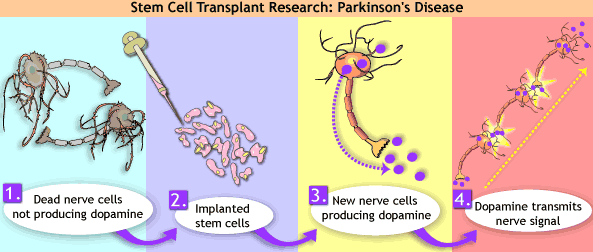 |
| Previous Image | Next Image |
| Description: Patients with Parkinson's disease are treated with the drug levodopa (or L-dopa), which is converted to dopamine in the body. Initially effective, the treatment's success is reduced over time and side effects increase, leaving the patient helpless.41 It has been recognized that dopamine-producing cells are required to reverse Parkinson's disease. Since the 1970s, many types of dopamine-producing cells have been used for transplantation. These include adrenal glands from the patient, human fetal tissue and fetal tissue from pigs.42 Limited success has been achieved with these cells. Rat and monkey models of Parkinson's were used to test fetal mesencephalic cells.41 Success with animal models led to clinical trials. Fetal tissue transplantation has been performed in 350 patients, including trials using pig fetal tissue. So far, the success of reversing Parkinson's disease using fetal tissue has been limited at best. However, in the most successful cases, patients have been able to lead an independent life without L-dopa treatment.43 The limitations include (i) lack of sufficient tissue for the number of patients in need, (ii) variation in results between patients ranging from no benefit to reversal of symptoms, and (iii) Occurrence of uncontrolled flailing movements (called dyskinesias). The many criteria for the cells used in therapy include the ability to produce dopamine, to divide and survive in the brain and to integrate into the host brain. For these reasons, differentiated embryonic stem cells offer more promise. Mouse ES cells have been used in rat models of Parkinson's disease and recently human ES cells have been reported to differentiate into dopamine-producing neurons in culture.44 Another consideration is the immune problem. It was believed that the brain is an immunologically privileged site tolerating transplanted cells from a different individual (meaning that the immune system will not attack tissue transplanted into this location). However, a recent report challenges this view.45 For this reason autologous cells may offer a safer alternative. Neural stem cells and hematopoietic stem cells are both likely candidates.31 Also, dental pulp cells in both rats and humans produce neurotrophic factors and are a candidate for autologous transplantation in Parkinson's.20 Picture Stats: Views: 1155 Filesize: 26.12kB Height: 252 Width: 593 Source: https://biology-forums.com/index.php?action=gallery;sa=view;id=11539 Keywords: Patients with Parkinson's disease embroyonic stem cell treatment |
